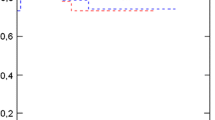Breast cancer laterality of over 250,000 cases from the Surveillance, Epidemiology, and End Results (SEER) program in the United States was studied in relation to gender, race, tumor stage, histology, age at diagnosis, year of diagnosis, estrogen receptor status, and marital status. The data, which include all invasive and in situ breast cancer cases in the SEER program during the years 1973–92, confirm results from other studies of an overall five percent excess of left-sided disease in women. The excess occurs for all races and stages of disease, and for invasive disease, the excess increases with age. There was no significant variation in the laterality of invasive disease over time, though for in situ tumors, the left-sided excess was significantly greater during the years 1978–82 than in other periods. No excess of left-sided breast cancer was observed among men. There is no evidence that detection bias plays a major role, and although the left breast is slightly larger, on average, than the right, there is little evidence that breast size is associated with breast cancer risk. The reason for the left-sided excess among women remains unclear.
Similar content being viewed by others
References
Busk T, Clemmesen J. The frequencies of left- and right-sided breast cancer. Br J Cancer 1947; 1: 345–51.
Garfinkel L, Craig L, Seidman H. An appraisal of left and right breast cancer. JNCI 1959; 23: 617–31.
McManus IC. Predominance of left-sided breast tumours. Lancet 1977; ii: 297.
Blot WJ, Fraumeni JFJr, Young JLJr. Left-sided breast cancer. Lancet 1977; ii: 762–3.
Senie RT, Rosen PP, Lesser ML, Snyder RE, Schottenfeld D, Duthie K. Epidemiology of breast carcinoma II: Factors related to the predominance of left-sided disease. Cancer 1980; 46: 1705–13.
Ekbom A, Adami HO, Trichopoulos D, Lambe M, Hsieh C-c, Ponten J. Epidemiologic correlates of breast cancer laterality (Sweden). Cancer Causes Control 1994; 5: 510–6.
Ries LAG, Miller BA, Hankey BF, Kosary CL, Harras A, Edwards BK, eds. SEER Cancer Statistics Review 1973–1991: Tables and Graphs. Bethesda, MD (USA): US Department of Health and Human Services, 1994; NIH Pub. No. 94–2789.
Armitage P, Berry G. Statistical Methods in Medical Research. Oxford, UK: Blackwell Scientific Publishers, 1987: 115–20, 205–8.
Trichopoulos D, Lipman RD. Mammary gland mass and breast cancer risk. Epidemiology 1992; 3: 523–6.
Ing R, Ho JHC, Petrakis N. Unilateral breast-feeding and breast cancer. Lancet 1977; ii: 124–7.
Gray H. Anatomy, Descriptive and Surgical. Reprinted: Pick TP, Howden R, eds. Philadelphia, PA (USA): Running Press, 1974: 1038.
Senie RT, Saftlas AF, Brinton LA, Hoover RN. Is breast size a predictor of breast cancer risk or the laterality of the tumor? Cancer Causes Control 1993; 4: 203–8.
Hsieh C-c, Trichopoulos D. Breast size, handedness and breast cancer risk, Eur J Cancer 1991; 27: 131–5.
Deapen DM, Pike MC, Casagrande JT, Brody GS. The relationship between breast cancer and augmentation mammoplasty: an epidemiologic study. Plast Reconstr Surg 1986; 77: 361–7.
Kolonel LN, Nomura AMY, Lee J, Hirohata T. Anthropometric indicators of breast cancer risk in postmenopausal women in Hawaii. Nutr Cancer 1986; 8: 247–56.
Berkel H, Birdsell DC, Jenkins H. Breast augmentation: a risk factor for breast cancer? N Engl J Med 1992; 326: 1649–53.
Byrne C, Schairer C, Wolfe J, et al. Mammographic features and breast cancer risk: effects with time, age, and menopause status. JNCI 1995; 87: 1622–9.
Thurfjell E, Hsieh C-c, Lipworth L, Ekbom A, Adami HO, Trichopoulos D. Breast size and mammographic pattern in relation to breast cancer risk. Eur J Cancer Prev 1996; 5: 37–41.
Brisson J, Verreault R, Morrison AS, Tennina S, Meyer F. Diet, mammographic features of breast tissue, and breast cancer risk. Am J Epidemiol 1989; 130: 14–24.
Hartveit F. The side and size of breast tumors. Clin Oncol 1983; 9: 135–42.
Garson AJr. The Science and Practice of Pediatric Cardiology. Vol 1. Bricker JT, McNamara DG, eds. Philadelphia, PA (USA): Lea & Febiger, 1990: 904.
Glass AG, Hoover RN. Rising incidence of breast cancer: Relationship to stage and receptor status. JNCI 1990; 82: 693–6.
Additional information
Authors are with the Division of Cancer Epidemiology and Genetics, National Cancer Institute, Bethesda, MD, USA. Address correspondence to Dr Weiss, Environmental Epidemiology Branch, Division of Cancer Epidemiology and Genetics, National Cancer Institute, Executive Plaza North Rm 443, 6130 Executive Blvd., Bethesda, MD 20892-7374, USA.
Rights and permissions
About this article
Cite this article
Weiss, H.A., Devesa, S.S. & Brinton, L.A. Laterality of breast cancer in the United States. Cancer Causes Control 7, 539–543 (1996). https://doi.org/10.1007/BF00051887
Received:
Accepted:
Issue Date:
DOI: https://doi.org/10.1007/BF00051887




